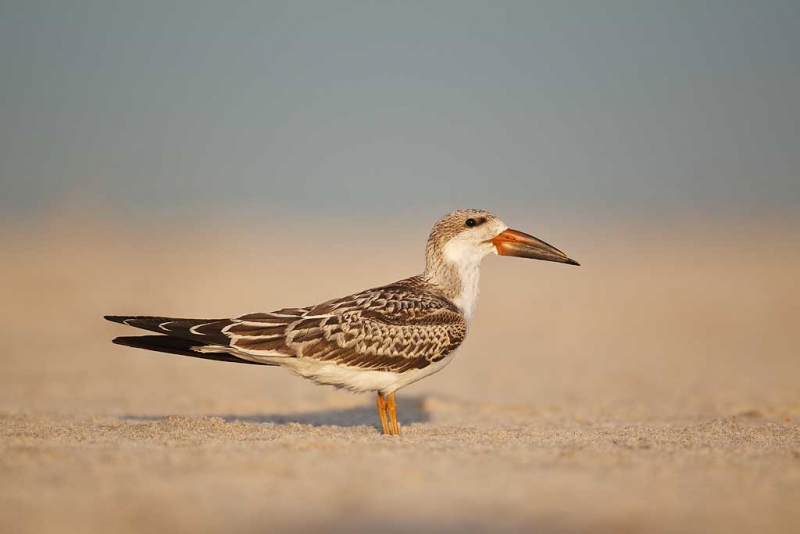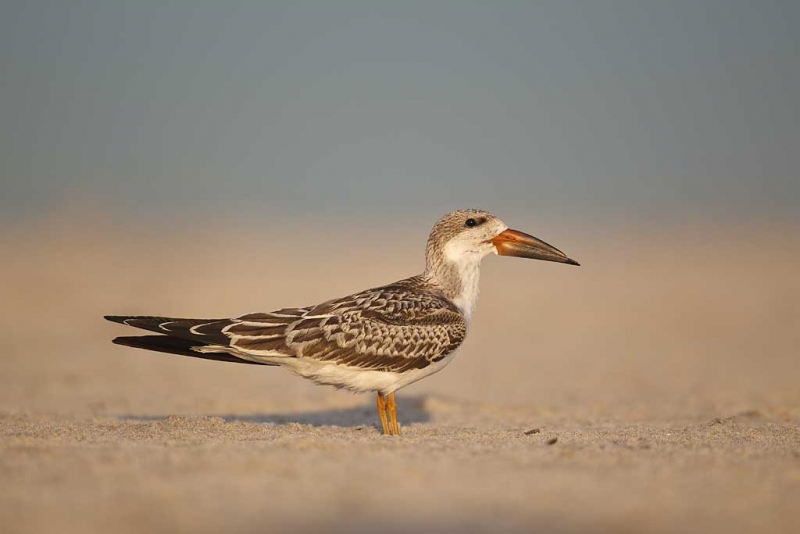|
This image of a young Black Skimmer resting on the beach was created at ground level with the tripod-mounted Canon 800mm f/5.L IS lens and the discontinued Canon EOS-1D Mark IV. ISO 400. Evaluative metering +1 stop: 1/800 sec. at f/5.6 in Manual mode. Central Sensor on the bird’s eye/AI Servo Rear Focus and recompose. Click here if you missed the Rear Focus Tutorial. Be sure to click on the image to enjoy a larger version. |
So Simple, So Sweet
With a north by slightly northwest wind at Nickerson Beach on Sunday morning things were quite tough; for the most part the birds were flying and facing away from the sun. To compound matters, there were four Japanese photographers who had no clue as to proper field etiquette. Several times denise and Matthew Bologna, a new friend whom we met that morning, had belly-crawled up to some beautiful juvie Common Terns only to have one of the group of four walk right by the birds at full speed and flush them. After the third time I approached one of the four and explained as politely as I could that they needed to walk slowly in such situations and/or give the folks on the ground a wider berth. I asked him to share that information with his buddies. Apparently he did not. Look forward to my publishing an updated article on field etiquette soon.
In any case, I was very happy with the image above. The young Black Skimmer is in fresh juvenal plumage. If you agree, leave a comment and let us know what factors you think contribute to the success of the image. If not, let us know why you do not like it. In either case, please be specific. And let us know if you have any suggestions that would improve the master file above.
|
Compare the original image immediately above with the JPEG that represents the master file at the head of this blog post and note the differences. |
As you can see in the image above that represents the original RAW capture, I did just a bit of beach, face, and neck cleanup. As always, I used the Patch Tool, the Spot Healing Brush, and a Quick Mask or two. All as described in detail in our Digital Basics File, a PDF that is sent by e-mail. DB includes dozens of great Photoshop tips, my complete digital workflow, and free updates. I must complete the next update in September when I will be home for five weeks. 🙂
Shopper’s Guide.
Support both the Bulletins and the Blog by making all your B & H purchases here.
Below is a list of the gear talked about in this blog post. Thanks a stack to all who have used the Shopper’s Guide links to purchase their gear as a thank you for all the free information that we bring you on the Blog and in the Bulletins. Before you purchase anything be sure to check out the advice in our Shopper’s Guide.
Canon 800mm f/5.6L IS lens. Right now this is my all time favorite super-telephoto lens.
The Canon EOS-1D Mark IV professional digital camera body has been discontinued. With the new professional body, the full frame EOS-1DX, focusing only to f/8, it is my belief that discontinuing the Mark IV is quite unfortunate for a variety of reasons.
And from the BAA On-line Store:
LensCoats. I have a LensCoat on each of my big lenses to protect them from nicks and thus increase their re-sales value. All my big lens LensCoat stuff is in Hardwood Snow pattern.
LegCoat Tripod Leg Covers. I have four tripods active and each has a Hardwood Snow LegCoat on it to help prevent further damage to my tender shoulders 🙂 And you will love them in mega-cold weather….
GT3532 LS. This one replaces the GT3530LS Tripod and will last you a lifetime. I’ll be commenting on this new model soon. In short, I like it.
Mongoose M3.6 Tripod Head. Right now this is the best tripod head around for use with lenses that weigh less than 9 pounds. For heavier lenses, check out the Wimberley V2 head.
CR-80 Replacement Foot for Canon 800. When using the 800 on a Mongoose as I do, replacing the lens foot with this accessory lets the lens sit like a dog whether pointed up or down and prevents wind-blown spinning of your lens on breezy days by centering the lens directly over the tripod.
Double Bubble Level. You will find one in my camera’s hot shoe whenever I am not using flash.
The Lens Align Mark II. I use the Lens Align Mark II pretty much religiously to micro-adjust all of my gear an average of once a month and always before a major trip. Enjoy our free comprehensive tutorial here.
BreezeBrowser. I do not see how any digital photographer can exist without this program.
















Previous records show itinerant African Skimmers in Israel in the 1930’s and Morocco in the 1980’s – so you will be delighted to know that a Black Skimmer was sighted last week on 30th August off the coast of Ireland in County Mayo! But I don’t think I’ll be packing my bag yet!
Good plan!
Sweet it is… and Sweet is was….
Thnx, DSG
Art, I don’t know if it’s me, or if it’s real, but I’m seeing a series of arched lines in the sky portion of the images. I didn’t notice till I looked at the large version, but now I can see it in the smaller versions too. I have seen this before when some elements of editing programs are too strong.
Dennis
Hi Dennis, Nothing was done to the sky here at all–the artifacts that you are seeing are a result of JPEG compression.
Wonderful image! Sweet light, tack sharp and the low angle are the factors pleasing me the most. But what are those arches clearly visible on the blue BG. Is it my eyes or the monitor, or maybe something happened during the post processing.
Seppo, Thanks. See my comments on JPEG compression here.
Art, when do you use your Canon 5d mkIII vs. your Canon 1d mkIV? I am trying to decide which of the two bodies I will up-grade to from a Canon 1d mkII. Thank you for you time. Do you think a Canon 1d mkIII is still worth buying. Thank you, Graham Hedrick
I go with the Mark IV when it is difficult to get close to the birds or wildlife; though it is a close call, it provides more pixels on the subject. That said some fine photographers feel that the better image quality of the 5D III and more accurate AF system make up for the small difference in the pixel math and go with the 5D III over the MIV. See lots more info in the blog post here. Note: I will be getting my EOS-1DX quite soon.
I have Digital basics and I’m slowly (sorry) making my way through it during 15 minute intervals at work. Will your update include your new Nik Software workflow? I’d like to see that…
Hi Andrea, The more you study and practice the more you will learn. Pretty much all the NIK stuff that will be in the next DB update has already appeared on the blog (for free). 🙂
Great shot only thing that I see that I would do, is to remove the darker line in the foreground.
Don
Ah, the faint dark shadow. I agree. I did not see that until I posted the image. I will go to the master file and remove it with a soft Clone Stamp brush. So thanks!
For whatever reason, Skimmers are not found on this side of the pond, so I am quite fascinated by them. I like the simplicity of this shot and am interested to see the juvenile plumage – it really is quite delightful! You appear to have brightened the image overall – how does the histogram look for the respective images – out of the camera and post processing? How far were you into the right 20% bracket?
Best wishes, Gerald
There are skimmers on your side of the pond in Africa and India though. The exposure and histogram for the original image was perfect. The optimized image is brighter because I moved the Brightness slider during the ACR conversion (as described in detail in Digital Basics). The Brightness slider is akin to the midtone slider in Levels. Thus, the histograms for both images show data almost up to the right side of the fifth box. Just like I preach. 🙂
Artie: it’s a great photo, for the reasons you give. Simple, nicely composed, good sharpness and color, and so on. You’ve left more space to the right of the bird than to the left, which I need to think more about. I like the low angle a lot, but one small downside for me is that you can’t see the bird’s feet, so it looks as if it’s standing in soft sand. I think the tradeoff is worth it, though, to get the rest of the composition.
David
To learn the basics of composition, see in both ABP and ABP II. You can save $10 on the two book bundle here (or study the info if you already have both of them.) Both will tell folks that the general rule is to have at least twice as much room in front of the bird then behind the bird, and twice as much room above the bird than below. The bird is standing on soft sand. I was lucky that he was standing up on a small rise so that we can see as much of the legs as we do. The only way to see s skimmer feet in this type of image would be if it were standing on hard sand after a rain, a parking lot, or very wet wave-washed sand.
Thanks, Artie. Your answers are educational as always. I do have ABP, and I went and looked at some of my own favorite images, and it seems I do usually allow the bird more room in front and above than below and behind. I don’t know why that question occurred to me in this case; as I said, and you helped me with, I need to think some more.
So were the bird’s feet actually buried in the sand? Does that affect their mobility?
YAW. Not buried at all, just slightly covered.
I would have preferred to see a more-focused foreground. But the 800 probably does not allow for much DOF range at your distance from the subject. The subject is perfectly focused and brilliant.
In many ways, the juvenile is more interesting than the adult.
A good thought. Just a bit more sand in front of the bird in focus would have been nice. I could have stopped down at least to f/8. The background would not have been affected.
I like this shot. Of course, nice clean shot of the bird. The background is nicely blurred. The top of the birds head is aligned right with the change of colors from sand to sky. The shot looks ready for publication in a field guide.
All Artie’s shots are ready for publication! 😉